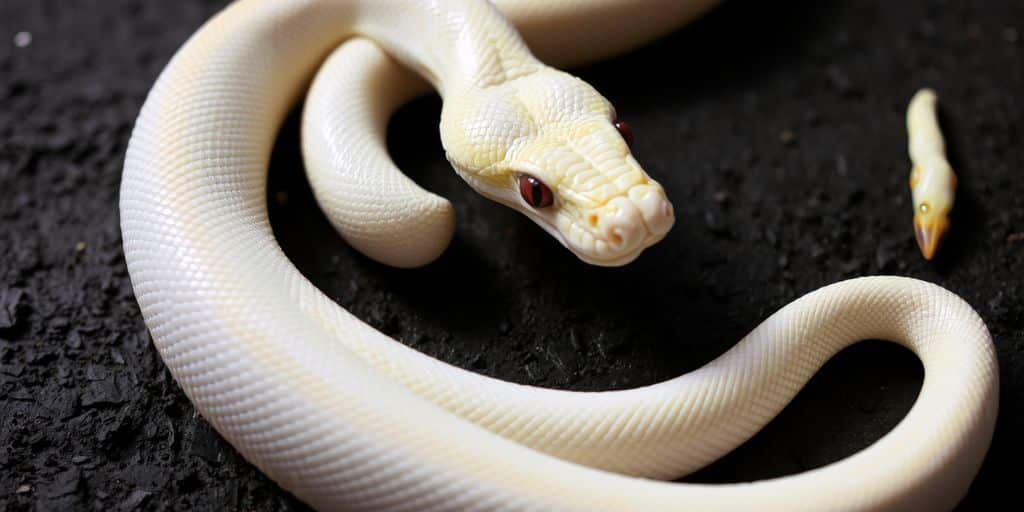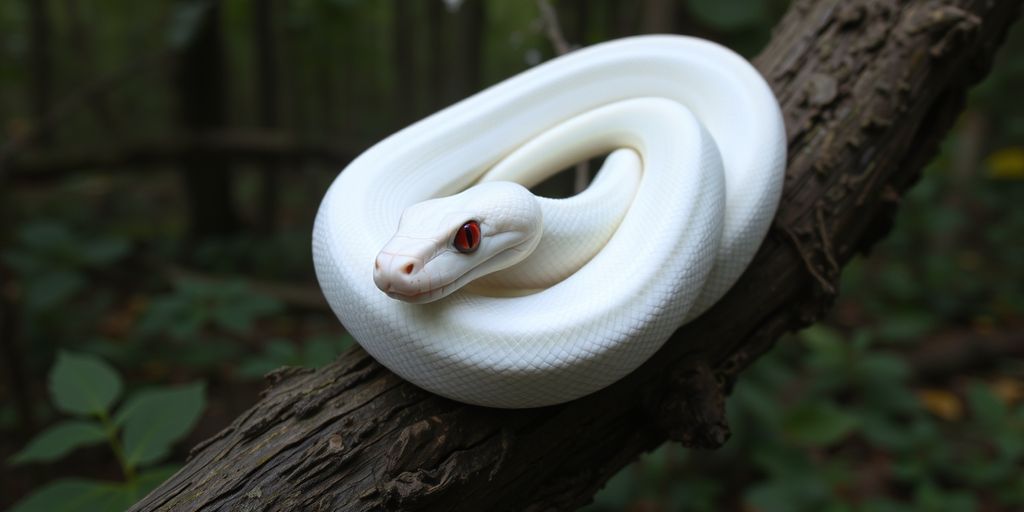Albino snakes are some of the most captivating creatures in the animal kingdom. Their lack of pigmentation gives them a unique appearance that stands out in nature. These snakes, which can be found in various species, have a distinct beauty that fascinates scientists and snake enthusiasts alike. However, their unique traits also come with challenges, especially in the wild.
Key Takeaways
- Albino snakes lack pigmentation, giving them a unique and striking appearance.
- These snakes face higher risks from predators due to their lack of natural camouflage.
- Albino snakes are sensitive to sunlight, which can affect their health.
- Several species of albino snakes are popular pets, but they require special care.
- Conservation efforts are important to protect albino snake populations in the wild.
Understanding Albinism in Snakes

Genetic Causes of Albinism
Albinism in snakes is a hereditary condition that results from a genetic mutation. This mutation affects the production of melanin, the pigment responsible for coloring the skin, eyes, and scales. Without melanin, albino snakes exhibit a lack of color, appearing white or pale.
Physical Characteristics of Albino Snakes
Albino snakes are easily recognizable due to their distinct appearance. They typically have white or pale skin and scales, and their eyes are often pink or red because the blood vessels show through the transparent irises. These unique features make albino snakes stand out in the wild.
Common Misconceptions About Albino Snakes
There are several misconceptions about albino snakes. One common myth is that they are a different species, but in reality, albinism can occur in any snake species. Another misconception is that albino snakes are more aggressive, which is not true. They are just as docile as their non-albino counterparts.
Albinism, from the Latin albus, meaning “white,” is a genetic condition characterized by the absence of pigment in the eyes, skin, hair, scales, or feathers.
The Unique Beauty of Albino Snakes
Color Variations in Albino Snakes
Albino snakes are known for their distinctive coloration, which often includes shades of white, yellow, and pink. These colors result from the lack of melanin, the pigment responsible for darker hues. The absence of melanin allows other pigments to become more prominent, creating a striking appearance that sets albino snakes apart from their non-albino counterparts.
Patterns and Markings
Despite their lack of typical pigmentation, albino snakes can still exhibit a variety of patterns and markings. These patterns can include stripes, spots, and blotches, which are often highlighted by the contrasting light colors. The unique patterns make each albino snake a one-of-a-kind specimen, adding to their allure and fascination.
Photographing Albino Snakes
Photographing albino snakes can be a rewarding experience due to their unique appearance. When capturing these snakes on camera, it’s essential to consider lighting and background to enhance their colors and patterns. Natural light often works best, as it brings out the subtle hues and intricate details of their scales. Additionally, a plain background can help the snake’s features stand out more prominently.
Albino snakes, with their striking colors and patterns, offer a glimpse into nature’s incredible diversity and beauty.
Challenges Faced by Albino Snakes in the Wild

Predation Risks
Albino snakes face significant predation risks due to their lack of camouflage. Their bright, white coloration makes them easily visible to predators, especially in dense forests or grassy areas. This lack of natural camouflage means they must be extra cautious and alert to avoid being spotted and hunted.
Sensitivity to Sunlight
Albino snakes are highly sensitive to sunlight because they lack melanin, the pigment that protects against UV rays. This condition, known as photophobia, makes it difficult for them to be active during the day. They are prone to sunburn and other skin issues, which can be detrimental to their health.
Survival Strategies
Despite these challenges, albino snakes have developed various survival strategies. They often seek shelter during the day to avoid predators and the harsh sun. Additionally, they may be more active during dawn and dusk when the light is less intense. These adaptations help them navigate their environment and increase their chances of survival.
Popular Species of Albino Snakes
Albino Ball Python
The albino ball python is a favorite among snake lovers. Originating from West Africa, these snakes are known for their striking yellow and white patterns. Their bright colors make them stand out, which unfortunately makes them more visible to predators in the wild.
Albino Corn Snake
Albino corn snakes are another popular choice for reptile enthusiasts. These snakes have a beautiful mix of white, red, and orange colors. They are easy to care for and are often recommended for beginners.
Albino Burmese Python
The albino Burmese python is one of the largest albino snakes. They can grow to impressive lengths and have a stunning yellow and white coloration. However, their size means they require a lot of space and care.
Albino snakes, like the albino Burmese python, are particularly popular among collectors due to their unique appearance and rarity.
Caring for Albino Snakes as Pets
Habitat Requirements
Creating a suitable habitat is crucial for the well-being of albino snakes. It’s essential to maintain an environment containing temperatures between 76 and 93°F and humidity levels between 50 and 60% to replicate their natural surroundings. A terrarium or aquarium with a secure locking mechanism is ideal. Ensure it is long and deep enough for the snake to move freely.
Diet and Feeding
Albino snakes have specific dietary needs. They primarily eat rodents, such as mice and rats. It’s important to feed them prey that is appropriately sized for their age and size. Feeding should occur every 1-2 weeks, depending on the snake’s age and activity level.
Health Concerns
Albino snakes can be prone to certain health issues, such as sensitivity to sunlight and skin problems. Regular check-ups with a veterinarian experienced in reptile care are recommended. Keep an eye out for signs of illness, such as changes in appetite or behavior, and address them promptly.
Owning an albino snake can be a rewarding experience, but it requires dedication and proper care to ensure the snake’s health and happiness.
Conservation Efforts for Albino Snakes
Threats to Albino Snake Populations
Albino snakes face numerous threats in the wild. Their bright colors make them easy targets for predators, and they often struggle to survive in their natural habitats. Additionally, habitat destruction and climate change further endanger their populations.
Breeding Programs
To help preserve albino snakes, various breeding programs have been established. These programs aim to increase the population of albino snakes by breeding them in controlled environments. This not only helps in maintaining their numbers but also ensures that the genetic diversity of these snakes is preserved.
Public Awareness and Education
Raising public awareness about the importance of albino snakes is crucial for their conservation. Educational programs and campaigns can help people understand the unique beauty and ecological significance of these snakes. By educating the public, we can foster a sense of responsibility towards protecting these fascinating creatures.
Conservation efforts are essential to ensure that albino snakes continue to thrive in the wild. By addressing the threats they face and promoting breeding programs and public awareness, we can help secure a future for these unique and beautiful reptiles.
Cultural Significance of Albino Snakes
Myths and Legends
Albino snakes have long been subjects of myths and legends across various cultures. In some traditions, they are seen as omens or symbols of purity and transformation. For instance, in certain Native American folklore, albino snakes are believed to be messengers from the spirit world, bringing important messages to those who encounter them.
Symbolism in Different Cultures
The symbolism of albino snakes varies widely. In Eastern cultures, they are often associated with good fortune and prosperity. Conversely, in some Western cultures, they might be viewed with suspicion or fear due to their unusual appearance. Despite these differences, albino snakes universally captivate the human imagination.
Albino Snakes in Media
Albino snakes have also made their mark in media and popular culture. They frequently appear in movies, TV shows, and literature, often symbolizing mystery or otherworldliness. Their unique appearance makes them a favorite choice for filmmakers and authors looking to add an element of intrigue to their stories.
The fascination with albino snakes is not just limited to their physical appearance but extends to the rich tapestry of stories and meanings woven around them in various cultures.
Conclusion
In conclusion, albino snakes are truly one of nature’s unique beauties. Their lack of pigmentation makes them stand out in the animal kingdom, showcasing a rare and fascinating aspect of genetic diversity. Despite the challenges they face, such as increased vulnerability to predators and sensitivity to sunlight, these snakes continue to captivate and inspire us. By learning more about albino snakes, we can appreciate the incredible variety and adaptability of life on Earth. Let’s continue to marvel at these extraordinary creatures and work towards their conservation, ensuring that future generations can also witness their unique charm.
Frequently Asked Questions
What causes albinism in snakes?
Albinism in snakes is caused by a genetic mutation that affects the production of melanin, the pigment responsible for their color. This mutation is inherited from the parents.
Are albino snakes more vulnerable in the wild?
Yes, albino snakes are often more vulnerable in the wild because their lack of natural camouflage makes them more visible to predators. They also have increased sensitivity to sunlight, which can affect their survival.
Do albino snakes have health problems?
Albino snakes can have certain health issues, such as sensitivity to light, which can affect their eyes and skin. However, with proper care, they can live healthy lives as pets.
What do albino snakes eat?
Albino snakes have the same diet as non-albino snakes. They typically eat small mammals like mice and rats. The specific diet can vary depending on the species.
Can albino snakes be kept as pets?
Yes, albino snakes can be kept as pets. They require specific care, including proper habitat, diet, and health monitoring, to ensure they live a healthy and comfortable life.
Are albino snakes rare?
Albino snakes are relatively rare in the wild due to their genetic mutation and the challenges they face in natural environments. However, they are more commonly found in captivity through selective breeding.
